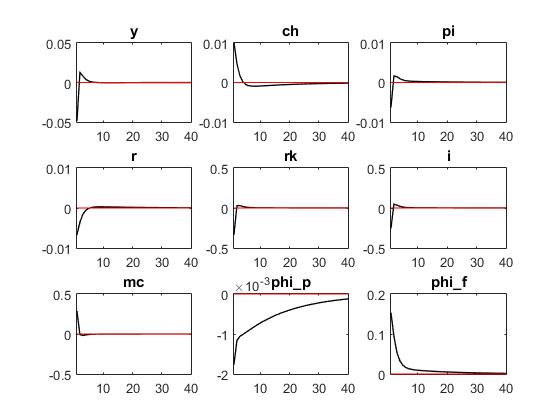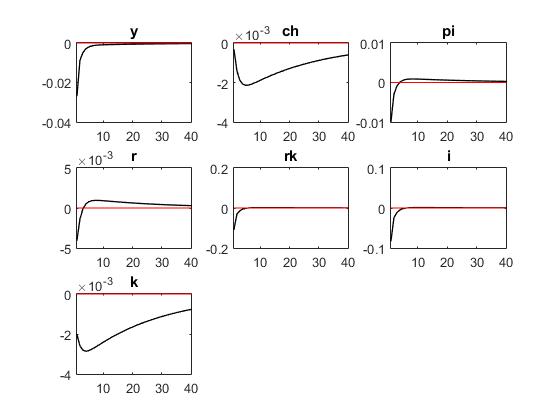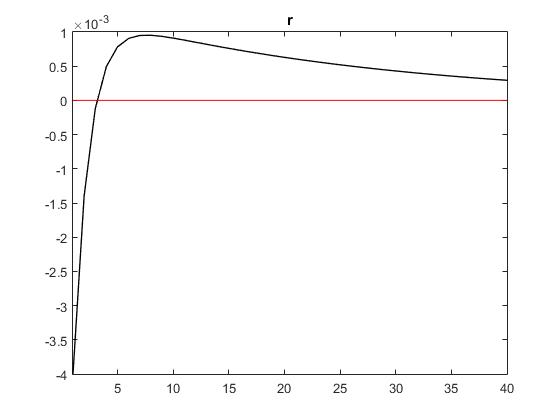Dear all:
When I attempt to a modeling of price addition of the retailer, question appears.It’s not a complicated problem.But I can’t find the problem, I’m tortured. Can someone can find out the error in my model? I would appreciate it very much.

deleverage12.mod (3.1 KB)
deleverage13.mod (2.7 KB)
model.pdf (113.6 KB)
%----------------------------------------------------------------
% 1. Defining variables
%----------------------------------------------------------------
var y ch ce w l pi r rk k i x
a ;
varexo eps_a ;
parameters alpha gamma sigmma delta beta theta nu omega lambda
kappa_r kappa_y kappa_pi rho_a rho_pi rho_r chi rho_x ce_ss s_ss
phi_f_ss phi_p_ss l_ss a_ss mu_p_ss x_ss r_ss rf_ss rk_ss
w_ss k_ss i_ss y_ss f_ss n_ss d_ss cb_ss ch_ss ;
alpha = 0.5 ;
gamma = 1 ;
sigmma = 1 ;
delta = 0.025 ;
beta = 0.99 ;
theta = 0.85 ;
nu = 0.97 ;
omega = 0.002 ;
lambda = 0.19 ;
rho_a = 0.5 ;
rho_x = 0.5;
rho_pi = 0.5 ;
rho_r = 0.5 ;
kappa_r = 0.8 ;
kappa_y = 0.5 ;
kappa_pi = 1.5 ;
phi_f_ss = 10 ;
phi_p_ss = 2 ;
l_ss = 1/3 ;
a_ss = 1 ;
mu_p_ss = 1;
q_ss = 1;
x_ss = 1.1;
r_ss = 1 / beta ;
rf_ss = (1 - nu * r_ss - phi_f_ss * omega )/ (phi_f_ss * nu ) + r_ss;
rk_ss = 1 / beta - (1 - delta) ;
k_ss = (rk_ss * x_ss / alpha)^(1/(alpha - 1 ) ) * l_ss ;
w_ss = (1 - alpha ) * (alpha^alpha / rk_ss^alpha)^(1/(1-alpha))/x_ss ;
i_ss = delta * k_ss ;
y_ss = a_ss * k_ss^alpha * l_ss^(1 - alpha);
s_ss = k_ss / phi_p_ss ;
f_ss = k_ss - s_ss ;
n_ss = f_ss / phi_f_ss ;
d_ss = f_ss * (phi_f_ss - 1) / phi_f_ss;
ce_ss = y_ss/x_ss + f_ss - i_ss - rf_ss * f_ss - w_ss * l_ss;
cb_ss = (1 - nu) * (rf_ss * f_ss - r_ss * d_ss);
ch_ss = y_ss - cb_ss - ce_ss;
chi = ch_ss^(-sigmma) * w_ss / l_ss^gamma ;
%----------------------------------------------------------------
% 3. Model
%----------------------------------------------------------------
model(linear);
%%%%%%%%%% HOUSEHOLD PROBLEM %%%%%%%%%%%%%%%%%%%%%%%%%%%
//1. labor supply equation
w = sigmma * ch + gamma * l ;
//2. Euler equation
- sigmma * ch = - sigmma * ch(+1) + (r - pi(+1) );
%%%%%%%%%% FIRM PROBLEM %%%%%%%%%%%%%%%%%%%%%%%%%%%
//3.Entrepreneurial Resource Constraints
ce_ss * ce + w_ss * l_ss * (w + l) + i_ss *( i ) = y_ss / x_ss *( y - x ) ;
//4. Capital accumulation equation
k = (1 - delta) * k(-1) + (i_ss / k_ss) *( i );
//5. Production Function
y = a + alpha * k(-1) + (1 - alpha) * l ;
//6. Entrepreneurial Euler equation2
ce = ce(+1) - (1/sigmma)*(rk(+1) * rk_ss /(rk_ss + 1 -delta) );
//7. wages condition
w = y - l - x ;
//8. Rate of return on capital
rk = y - k(-1) - x ;
//9. philipus curve
pi = beta * pi(+1) - (1 - theta)*(1 - beta * theta) * x / theta ;
%%%%%%%%%% BANK PROBLEM %%%%%%%%%%%%%%%%%%%%%%%%%%%
//10. resource equation
y = (ch_ss/y_ss) * ch + (ce_ss/y_ss) * ce + (i_ss/y_ss) * i ;
//11. Taylor Rule
r = kappa_r * r(-1) + (1 - kappa_r) * (kappa_y * y + kappa_pi * pi) ;
//shocks
a = rho_a * a(-1) + eps_a;
end;
initval;
y=0.0;
ch=0.0;
w=0.0;
l=0.0;
pi=0.0;
r=0.0;
rk=0.0;
ce=0.0;
k=0.0;
i=0.0;
x=0.0;
a=0.0;
end;
resid(1);
steady;
check;
model_diagnostics;
shocks;
var eps_a =0.01^2;
end;
stoch_simul(irf=40,order=1,hp_filter=100,periods=2100)y ch pi r rk i x ;
 can r start from zero or one? like the picture. The steady state value of the marginal cost is (GAMMA - 1)/ GAMMA ?GAMMA is the substitution of elasticity,Is it right?
can r start from zero or one? like the picture. The steady state value of the marginal cost is (GAMMA - 1)/ GAMMA ?GAMMA is the substitution of elasticity,Is it right?